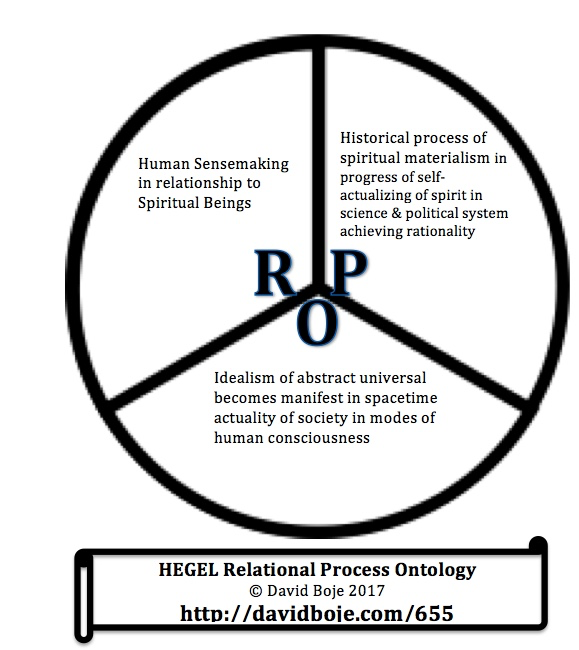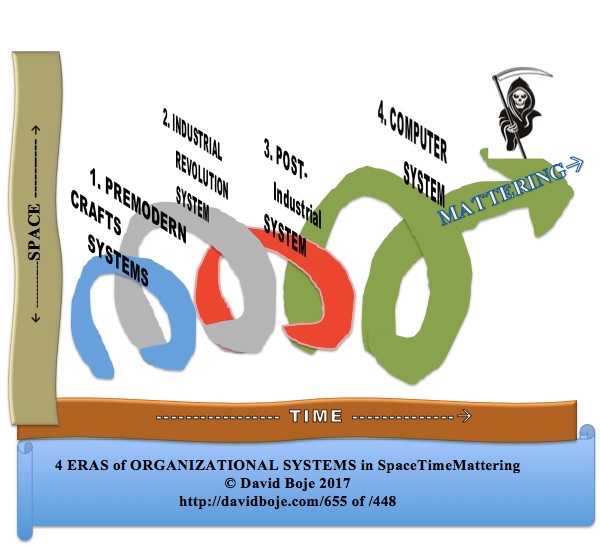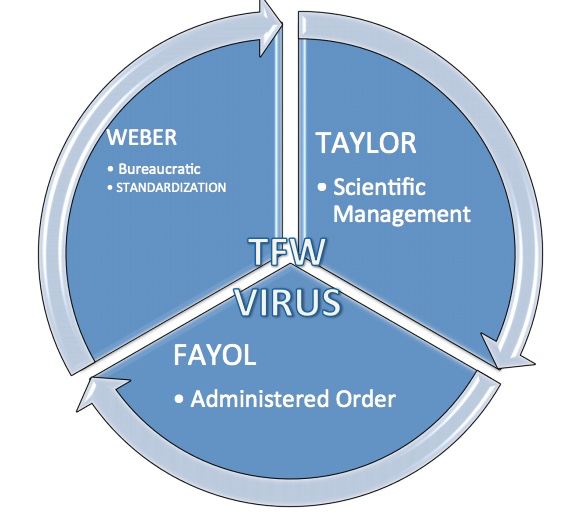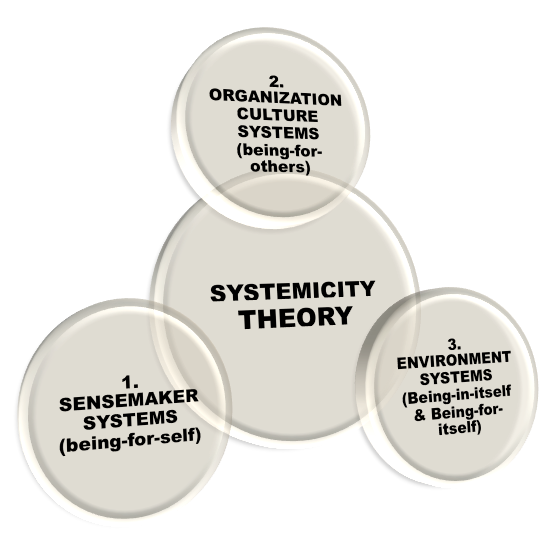Organizational Research Methods: Storytelling in ActionDavid M. Boje Book being prepared for Routledge, due March 2018 To cite this document: Boje, David M. (2018) "Organizational Resarch Methods: Storytelling In Action", (March 15), URL = <https://davidboje.com/ORM_Storytelling_in_Action_Book/index> |
Chapter - RPO2 Hegel's Dialectical Method
Georg Wilhelm Friedrich Hegel's Phenomenology of Spirit (1807) Let's look at this as a Hegel Dialectic (see Phenomenology of Spirit book: sections 393-394).Please download an e-book version of Hegel
Figure 1 - Hegel Relational Process Ontology
BOJE ORIGINAL YOUTUBE Hegel and Marx/Engels and what has happened to systems theory since them https://youtu.be/o0jzl8BQogs Youtube 10 minutes
SUMMARY" 2nd in series Organizational Research Methods by David Boje. This episode is about differences in Hegel dialectic and Marx/Engels historical materialism method, then develops 4 eras of history
1. Pre-modern when crafts, farms, ranches existed with spiritual
2. Industrial revolution took over and people went into factory system with what is called TFW Virus ->Taylorism, Fayolism, & Weberism
3. Post-Industrial service economy
4. COMPUTER SYSTEM era we are in now, everyone in late modern monopoly capitalism addicted to personal computers, cell phones, etc. And still have TFW Virus - we all in the Matrix --> Take the Blue Pill and stay in your computer addiction, and the story ends. Take the Red Pill and wake up to Marx and Engels historical materialism
NEXT EPISODE - Mary Parker Follett, the Mother of Systems Theory, all but forgotten in the craze for TFW Virus\
Figure 2 - 4 Eras of Organizational System
Figure 3 - TFW Virus (from Henri Savll's work
Hegel online Resources:
[PS] Download one of the Phenomenology of Spirit books on line by Hegel, Georg Wilhelm Friedrich (1807).
[PS] Size Phenomenology of Spirit - G. W. F. Hegel.epub 638.7 KB Phenomenology of Spirit - G. W. F. Hegel.mobi 1.04 MB [PR] Hegel, Georg Wilhelm Friedrich. (1820/1896/1942/1952). Philosophy of Right. (second version of same book) Preface and Introduction with certain changes in terminology: from, by G W F Hegel 1820. First Published: by G Bell, London, 1896. Translated: by S W Dyde, 1896. Prometheus Books; Remainder: from “Hegel’s Philosophy of Right”, 1820, translated, Oxford University Press; First Published: by Clarendon Press 1952, Translated: with Notes by T M Knox 1942.
- The Encyclopaedia Logic: Part 1 of the Encyclopaedia of Philosophical Sciences, trans. T. F. Geraets, W. A. Suchting, and H. S. Harris (Indianapolis: Hackett, 1991).
- Philosophy of Nature (Part Two of the Encyclopaedia of Philosophical Sciences), trans. Michael John Petry, 3 vols., (London: George Allen and Unwin, 1970).
- Hegel's Philosophy of Mind: Being Part Three of the Encyclopaedia of Philosophical Sciences, trans. William Wallace (Oxford: Clarendon Press, 1971).
Encyclopaedia of the Philosophical Sciences (1830) Part One by Georg Wilhelm Friedrich Hegel (first published in 1817, second edition 1827, third edition 1830[1]) and see in that piece section on "Philosophy of Nature" (click here for that).
[EL] Hegel, Georg Wilhelm Friedrich (1830/1991). The Encyclopedia Logic: Part 1 of the Encyclopaedia of Philosophical Sciences [Enzyklopädie der philosophischen Wissenschaften I], translated by T.F. Geraets, W.A. Suchting, and H.S. Harris, Indianapolis: Hackett, 1991.Click here to download PDF
Hegel (1830) writes of 'circles' not of spirals. Nevertheless, the circles that do not repeart their cycle exactly as before, can become spirals.
Hegelian Spirals
Hegel’s dialectic Notion is about the unfolding process “from abstract to concrete” historically in the “shape of successive systems, each based on a particular definition of the Absolute” (Hegel, [Shorter Logic, § 86n]). The earlier systems in the progression were more abstract. Each system was refuted by the successor, and at the same time the earlier system was still bought forth, in the evolution of system after system
It is like “a circle rounded and complete in itself” “The single circle, because it is a real totality, burst through the limits imposed by its special medium, and gives rise to a wider circle… resembles a circle of circles” “… constituted by the system of these peculiar phases, and each is a necessary member of the organization” (Hegel, [Shorter Logic§15]).
"Each of the parts of philosophy is a philosophical whole, a circle rounded and complete in itself. In each of these parts, however, the philosophical Idea is found in a particular specificality or medium. The single circle, because it is a real totality, bursts through the limits imposed by its special medium, and gives rise to a wider circle. The whole of philosophy in this way resembles a circle of circles. The Idea appears in each single circle, but, at the same time, the whole Idea is constituted by the system of these peculiar phases, and each is a necessary member of the organisation" (Hegel, 1830: § 15, Encyclopaedia of the Philosophical Sciences).
If we put this together with Hegel’s theory of systems and circles from other texts, then what I read is a spiral theory, where each circle becomes a whorl , each whorl (circle) bursting through its limits imposed by its medium in space, in time, and in mattering (Substance), and each whorl after system whorl is necessary to the spiral organizing.
In Hegel's (Philosophy of the Right:§ 63) more shapes than cirlce, such as ellipse and prabola are considered, that prove quantity with its quantum differences:
"The definition of a circle, an ellipse, and a parabola reveals their specific difference. But in spite of this, the distinction between these different curves is determined purely quantitatively, i.e. in such a way that the only important thing is a purely quantitative difference which rests on their coefficients alone, on purely empirical magnitudes. In property, the quantitative character which emerges from the qualitative is value. Here the qualitative provides the quantity with its quantum and in consequence is as much preserved in the quantity as superseded by it" (Hegel, Philosophy of the Right: § 63).
Dialectic Ratiocination, an Organizaiton Research Method
Ratiocination is part of syllogistic logic (& reasoning). It is how a general proposition by induction attains verification (or falsification) to become a specific proposition in particular case by the reduction of the syllogism (Mill,1846: 114, 292). John Stuart Mill (1846: 40) complimented Hegel for being more objective and ontological than Kant.
In Hegel (1807, Phenomenology of Spirit), ratiocinative methods are not to be mixed with speculation because the two research methods interfere with each other. Ratiocination is a process of logical (inducitive & deductive) reasoning in a skilled methodological process. Hegel contends that the proposition to be “dialectical movement” is a both/and of the ‘content’ of the proposition and the “opposite movement” both finding explicit expression of proof (Hegel, 1807: §65). This involves the “sublation of the form the proposition” attaining “dialectical movement” in “systematic exposition” (IBID, §65).
We can apply dialectical movement to our organizational system spiral theorizing and research. The dialectical spiraing system-movement “generates itself, going forth and returning, to itself”, whorl-by-whorl (Hegel, 1807: §65). Hegel says the dialectical movement of the proposition should not be separated from proof (IBID,§ 65). In other words, when there is no proof, the movement is being appraised externally by sensemaking and spiral becomes an empty form, a concept that lacks the dialectical movement of sublation. In spiralling, one whorl is sublated into the larger or smaller one, preserving something of the former, and lifting up negation of the negation, with positive consequence. Each whorl is the negation of the negation, in the higher whole that is itself open to further sublation, as one whorl supersedes, yet also preserves and maintains the unfolding spatializing, temporalizing moments, and the materializing substantiality of the spiralling movement.
There is practical application of ratiocinative process in the spiralling system spacetimematerializing. There are ratiocinative techniques of antenarrative anticipation that can be investigated to verify the reasoning. The detective story uses both inductive clue by clue accumulation, and deductive powers of reasoning in a ratiocinative process.
Being and knowing combine in the ratiocinative “ontological detective”, investigating the unfolding progress of spiralling, to “unravel the truth” (Cook,2011: p. 13). At the end of the detective narrative, there is the apprehension of a beginning, middle, and end. But in the antenarrative, the ratiocinative process poses the problems in need of solution before a narrative structure has been devised (Cook, 2011: p. 9).
The ratiocinative spiral method is a process of investigation where observing and comprehending are both part of the process of creating a ratiocinative exchange between antenarrative (fore-caring investigation & detecting) and narrative emplotment (& denouement about the shifts in reasoning). Ratiocinative essence of the deceptive genre envisaged by Edgar Allen Poe (e.g. The Murders in the Rue Morgue), which foregrounded the ratiocinative process of inductive and deductive reasoning by temporal displacement of sequential emplotment narrative structure (Cook, 2011: pp. 4, 113).
"EXTRAORDINARY MURDERS. - This morning, about three o'clock, the inhabitants of the Quartier St. Roch were roused from sleep by a succession of terrific shrieks, issuing, apparently, from the fourth story of a house in the Rue Morgue, known to be in the sole occupancy of one Madame L'Espanaye, and her daughter, Mademoiselle Camille L'Espanaye” (Poe, The Murders in the Rue Morgue).
The ratiocinative detective talks to witness, inspects the crime sense, reviews evidence, and so on to unravel the riddle.
Dominant narrative resolves mystery by retrospect didactic. Poe uses both the inductive and the deductive method to unravel the web of mystery by staying focused on the “ratiocinative process” (p. 8).
You can see this ratiocinative ontology in Poe's other works. The ratiocinative techniques are in the form of tarrying with induction and its antithesis, and also applying logical deductions and their antithesis, in the “discovery of the pit and its inviting chasm followed by the appearance of the bladed pendulum” in Poe’s The Pit and the Pendulum is a subversion of reason in “an arbitrary world of cruelty” with one set-back after another (Cook, 2011: p. 19).
The antenarrative-spiral process investigation is a quest for meaning by becoming an ontological deceptive using ratiocinative dialectical movement techniques of the ratiocinative organisational research method before their is a dominant narrative retrospection to represent the spiralling form in narrative construction of sequential narrative didactically. It is being inductive in accumulating clues, then switching to deductive elimination and verification as proof that is retrospective denouement.
Hegel's Sublation Theory and Neil Bohr's Quantum Principle of Correspondence
Hegel's historical approach is "sublation" anticipates a quantum principle (source).
"To sublate, and the sublated ... constitute one of the most important notions in philosophy. It is a fundamental determination which repeatedly occurs throughout the whole of philosophy, the meaning of which is to be clearly grasped and especially distinguished from nothing. What is sublated is not thereby reduced to nothing. ... 'To sublate' [aufhaben] has a twofold meaning in the language: on the one hand it means to preserve, to maintain, and equally it also means to cause to cease, to put an end to. Even 'to preserve' includes a negative element, namely, that something is removed from its influences, in order to preserve it. Thus what is sublated is at the same time preserved; it has only lost its immediacy but is not on that account annihilated" [Hegel, The Science of Logic, Book I, Becoming]
"These concepts must be retained just as they are simultaneously terminated in a new scientific theory based on new insights, and the principle of correspondence expresses in mathematical terms Hegel's principle of 'sublation'" "Niels Bohr introduced this principle under which a quantum interaction must be described in terms of wave-concepts and in terms of particle-concepts, and the two descriptions are together taken as a complete description of the properties of the interacting objects, despite the fact that no interaction can simultaneously correlate with both systems of concepts completely" (source).
Dialectic of thesis and antithesis:
"Each stage therefore either stands to that preceding it as an antithesis, which inevitably dogs its steps as an accusing spirit, or it is the conjunction of the original thesis with the antithesis, in a union which should not be called synthesis because it is a closer fusion and true marriage of minds" (Hegel, Philosophy of Mind, Essay1, p. 25).
" The play of forces is no doubt a unity: but its unity lies not in the synthesis of consciousness, but in the essential unity of Soul" (Hegel, Philosophy of Mind, Essay1, p. 56.).
Hegel's (1830) Notions of systems of philosophy can inform organization systems studies:
"The actuality of the rational stands opposed by the popular fancy that Ideas and ideals are nothing but chimeras, and philosophy a mere system of such phantasms. It is also opposed by the very different fancy that Ideas and ideals are something far too excellent to have actuality, or something too impotent to procure it for themselves" (Hegel, 1830: § 6, Encyclopaedia of the Philosophical Sciences).
"Stated in exact terms, such is the origin and development of philosophy. But the History of Philosophy gives us the same process from a historical and external point of view. The stages in the evolution of the Idea there seem to follow each other by accident, and to present merely a number of different and unconnected principles, which the several systems of philosophy carry out in their own way. But it is not so. For these thousands of years the same Architect has directed the work: and that Architect is the one living Mind whose nature is to think, to bring to self-consciousness what it is, and, with its being thus set as object before it, to be at the same time raised above it, and so to reach a higher stage of its own being. The different systems which the history of philosophy presents are therefore not irreconcilable with unity" (Hegel, 1830: § 13, Encyclopaedia of the Philosophical Sciences).
"The spectacle of so many and so various systems of philosophy suggests the necessity of defining more exactly the relation of Universal to Particular. When the universal is made a mere form and co-ordinated with the particular, as if it were on the same level, it sinks into a particular itself" (Hegel, 1830: § 13, Encyclopaedia of the Philosophical Sciences).
"The science of this Idea must form a system. For the truth is concrete; that is, while it gives a bond and principle of unity, it also possesses an internal source of development. Truth, then, is only possible as a universe or totality of thought; and the freedom of the whole, as well as the necessity of the several sub-divisions, which it implies, are only possible when these are discriminated and defined. Unless it is a system, a philosophy is not a scientific production. Unsystematic philosophising can only be expected to give expression to personal peculiarities of mind, and has no principle for the regulation of its contents" (Hegel, 1830: § 14, Encyclopaedia of the Philosophical Sciences).
Figure 4: System Storytelling about 1. Sensemaker Systems, 2. Organization Culture Systems, and 3. Environment Systems (ecology, supply chain, socio economy, etc.).
For great overview of differences between classic textbook reduction of Hegel to thesis-antithesis-synthesis [textbook-triadic] model and much more sophisticated Hegelian dialectics, see Maybee (2016). She reviews how in many places Hegel's dialectical method does not fit the thesis-antithesis-synthesis textbook model. We will not be using the classic textbook model in this course.
What is Hegel's dialectical?
" Dialectic is not that process in which an object or proposition, presented, to feeling or the direct consciousness, is analysed, entangled, taken hither and thither, until at last its contrary is derived. Such a merely negative method appears frequently in Plato. It may fix the opposite of any notion, or reveal the contradiction contained in it, as did the ancient scepticism, or it may in a feeble way consider an approximation to truth, or modern half-and-half attainment of it, as its goal. But the higher dialectic of the conception does not merely apprehend any phase as a limit and opposite, but produces out of this negative a positive content and result. Only by such a course is there development and inherent progress. Hence this dialectic is not the external agency of subjective thinking, but the private soul of the content, which unfolds its branches and fruit organically" (Hegel 1820, § 31 Philosophy of Right).
What is negation of the negation in the dialectic process?
"This appearance of right, in which right and its essential embodiment, the particular will, correspond immediately, i.e. fortuitously, proceeds in wrong to become a show, an opposition between the principle of rightness and the particular will as that in which right becomes particularised. But the truth of this show is its nullity and the fact that right reasserts itself by negating this negation of itself. In this process the right is mediated by returning into itself out of the negation of itself; thereby it makes itself actual and valid, while at the start it was only implicit and something immediate" (Hegel 1820, § 82 Philosophy of Right, boldness and italics, original; see also § 104).
Negation of the negation is defined here as the dialectic of two steps forward and one step back. Sometimes its three steps back. The point is there is no reason for the thesis and antithesis to be in balance or to merge into synthesis. Both the thesis and antithesis produce contradictions in their wake. In other words, within the thesis and within the antithesis, as well as between them, there is the negation of negation. How many contradictions is their in an organizational change effort to implement academic capitalism as the antithesis to the way universities, for example, expanded after world war II, when the knowledge society ideology advocated everyone who could muster get higher education. After the 1970s, the 2000, 2008, and more recent economic crises, state legislatures have taken three steps back to negate the knowledge society, and taken two steps forward to implement academic capitalism's knowledge economy ideology. What is the negation of each of the negations of thesis and antithesis that we are living through.
In this seminar we want to unpack the differences in Hegelian, Marxian, Baradian, and several other relational process ontologies of sociomateriality of organizational systems.
Maybee, Julie E., "Hegel's Dialectics", The Stanford Encyclopedia of Philosophy (Winter 2016 Edition), Edward N. Zalta (ed.), URL = <https://plato.stanford.edu/archives/win2016/entries/hegel-dialectics/>.
[EL] Hegel, Georg Wilhelm Friedrich (1830/1991). The Encyclopedia Logic: Part 1 of the Encyclopaedia of Philosophical Sciences [Enzyklopädie der philosophischen Wissenschaften I], translated by T.F. Geraets, W.A. Suchting, and H.S. Harris, Indianapolis: Hackett, 1991.Click here to download PDF
What is Hegel's dialectic? It has three moments of every logical concept that is true, in general (EL §79). I will translate it in terms of what I call 'storytelling in action' the working of narrative and counternarrative in organization studies.
First moment is 'fixity,' concepts [or forms] have a accepted stable definition (EL §80). E.g. the mission of a public university is to provide education of all persons in a knowledge society to elevate the goodness of life. Our university, on the other hand, says, "there are no limits an d no boundaries here",but of course there are many of both (contractions abound).
Second moment is 'dialectical' (EL §§79, 81) or “negatively rational” (EL §79), when a onesidedness of the reining narrative comes to the fore in first moment, and becomes its opposite, 'counternarrative' in the second moment. E.g. the mission of a public university is to provide education for people of means (or those taking on huge student debt obligations) in a knowledge economy [aka academic capitalism] resulting in a wider gap between rich and poor. The moment of ocunternarrative sublates (meaning to negate [cancel] and to still preserve, both at same time). In our example, the fixity grows in the dominant narrative and in the second moment it sublated as counternarrative emerges and becomes the opposite of the knowledge society, the knowledge economy university. However something of the old narrative of public university is still being preserved, and pushed on in dialectic stuggle. Most public universities around the world, are in this dialectical narrative-counternarrative moment (sublation to reverse public university mission since WWII, and hanging on to the old narrative of educaiton for all).
"The English verb “to sublate” translates Hegel’s technical use of the German verb aufheben" which has the double meaning (both to negate and to preserve at same time). The English 'sublate' is from German verb aufheben (PhG §113; SL-M 107; SL-dG 81–2; cf. EL the Addition to §95)" [as cited in Maybee, 2016].
Third moment is 'speculative' (or 'positively rational)(EL §§79, 82), grasping the unity of the transition of narrative-counternarrative dialectic (EL §82 and Remark to §82).Here, as Maybee (2016) notes, Hegel rejects Plato's form of dialectic, in which when premises of a concpet lead to contradictions, then those premises must be discarded, leaving nothingness. The speculative moment negates the contradiction (s), in what is called 'the negation of the negation.' The 'negation of the negation' is a specific process of understanding in the dialectical moment (overcom ing the restrictedness of both narrative and counternarrative, fixity [one-sidedness]).
Negation of the Negation Therefore Hegel asserts the 'speculative moment' is not nothing, and is actually part of the process and has a content. "The speculative moment is thus “truly not empty, abstract nothing, but the negation of certain determinations” (EL §82, as cited in Maybee, 2016). The moment of understanding (or meaning) will continue to sublate itself, into more contradictions to the fixity of narrative-counternarrative dialectic. There are assumed forces in the process that drive the thesis (narrative) to turn into its opposite antithesis (counternarrative) and to beome a third speculative moment that negates both their contradictions in negation of the negation (self-sublation stage of the process). E.g. Later public university missions and programs sublate earlier missions and programs. Later counternarrative sublates earlier dominant narratives. But in the sublation process, something of the ealier public university missionis preserved in the counternarrative moment by embracing a set of something-others, which I have called 'antenarratives' (the before-narrative and before-counternarrative, and bets [antes] on the future potentialities of public university.
Boje, D. M. & M. W. Lundholt. Editorial for special issue, on Counternarrative, accepted Nov 5, 2016, to be published in European J. of Cross-Cultural Competence and Management See pre-press PDF
Boje, D. M.; Svane, Marita; Gergerich, Erika. expected publication date (2016 or early 2017). "Counternarrative and Antenarrative Inquiry in Two Cross-Cultural Contexts". Accepted Nov 25, 2015, European J. of Cross-Cultural Competence and Management Click here for pre-publication pdf
Boje, D. M.; Hillon, Yue; Mele, Tara M. (2017). 21st Century University and the Failure of Business Process Reengineering.Accepted Jan 6 2017, will be published in Organization Development Journal, Spring 2017 - Volume 35, Number 1. Click here for pre-press PDF.
Being-for-itself the public university embraces some antenarrative potential futures (the something-others), and beings to fixate on one of these futures in its masterplans. For example, NMSU's fixity is to build a shopping mall, hotel ocmplex, and expand the golf course from 18 to 27 holes. This appears to some faculty and students as a 'contradiction' that negates (cancels) the mission of education, research, and service. For example, there is substantial resistance to using business models, such as business process reengineering (BPR) to reorganize the academic units of the university (Boje, Hillon, & Tara, 2017). There is an ongoing dialectical process of passing back-and-forth between narrative, counternarrative, and antenarrative fore-caring of the future (Boje, 2014; Boje, 2016; Henderson & Boje, 2016). We proposed a socioeconomic approach builds human potential and launches revenue development projects self-financed by diagnosing and redressing hidden costs (see in this web document, Savall’s Socioeconomic, Qualimetrics and Tetranormalizing).
In sum, the narrative and the counternarrative develop one-sidedness, which antenarrative speculative moments of prospective sensemaking sublate (cancel yet also preserve in a both/and move, rather than only the eaither/or move of narrative/counternarrative).
References
Cook, M. (2011). Narratives of Enclosure in Detective Fiction: The Locked Room Mystery. Springer.
Mill, John Stuart (1846). A System of Logic, Ratiocinative and Inductive: Being a Connected ..., Volume 1. online, accessed 8 Aug 2017



